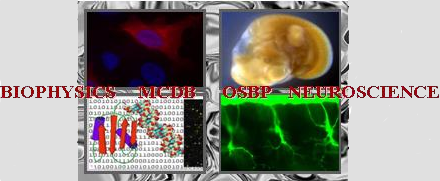Talk abstracts
Talk on Wednesday 04:30-04:45pm submitted by Timothy Grunkemeyer
Deciphering the roles of aspartate and histidine in the mechanism of the six-bladed β-propeller hydrolases
Timothy John Grunkemeyer (Ohio State Biochemistry Program), Kiran Doddapaneni (Department of Chemistry and Biochemistry), Srividya Murali (Department of Chemistry and Biochemistry), Gregory Friedberg (College of Arts and Sciences Neuroscience)
Abstract:
Each year over 3 million people are exposed to toxic organophosphorus compounds (OPs), which target the parasympathetic nervous system, leading to respiratory arrest and ultimately death. Since the current treatment is only moderately effective, we aim to generate a more effective therapeutic in the form of a catalytic bioscavenger. Paraoxonase-1 (PON1) has shown promise as a drug for OP treatment however, due to a plethora of conflicting evidence, its mechanism is poorly understood. This severely limits our abilities to engineer PON1 for improved activity and ultimately its therapeutic efficacy. In order to understand PON1’s mechanism, we aim to interrogate the active sites of the closely related six-bladed β-propeller hydrolases di-isopropylfluorophosphatase (DFPase), Drug responsive protein-35 (Drp35), and Senescence Marker Protein 30 (SMP30). We believe that all four enzymes operate via a common mechanism that can be elucidated through comparative enzymology and structural studies.
All four enzymes contain an upper calcium ligation sphere consisting of four residues: Asp, Glu, and two Asn. The residues of interest are this Asp and a His near the active site (His only present in PON1 and DFPase). It has been hypothesized that either of these residues can activate a water for substrate hydrolysis or attack the substrate directly forming an enzyme-substrate complex that is subsequently hydrolyzed. To test these hypotheses, we cloned, expressed, and purified a set of conservative mutations in all four enzymes. Subsequently, they were kinetically screened them against a panel of aryl esters, lactones, and OPs, and kcat/Km values were calculated to determine the effect on catalysis. In Asp to Asn mutations, we observe a complete loss in activity while the His to Phe mutants result in a 4x-8x increase in both kcat and Km in PON1 and DFPase. Interestingly, the His seems to be absent in both Drp35 and SMP30, being replaced with an Ala and Arg respectively. These observations argue against the His participating in catalysis, but supports its role in substrate binding. We believe these results support Asp being responsible for activity, whether directly or via water activation. Crystallographic analyses of notable mutants and 18O labeled water experiments are under way to decipher the Asp’s exact role in catalysis.
Keywords: hydrolase, organophosphate, bioscavenger
